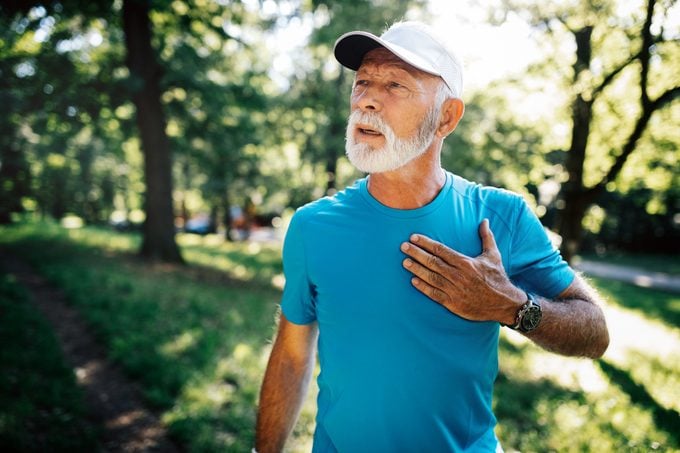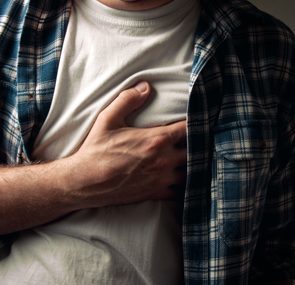8 Causes of Exercise-Related Chest Pain Besides a Heart Attack
Updated: Aug. 02, 2023
They say no pain, no gain when it comes to working out—but is chest pain normal? Heart docs explain the most common reasons for chest pain at the gym and when to get it checked out.
Chest pain shouldn’t be ignored. According to cardiologists, it’s one of the most common—and sometimes, subtle—signs of a heart attack, the leading cause of death in the United States. That said, a study published in PLoS One found that up to 90 percent of emergency room visits for chest pain wind up not being heart-related.
Still, overlooking chest pain can be dangerous. When Bob Harper, the super-fit celebrity trainer on The Biggest Loser, had a “widow-maker” heart attack while working out, it was a wake-up call to many people about heart disease, even in those who appear to be perfectly healthy.
“If you feel chest heaviness or pain that comes on with exercise and resolves with stopping exercise you should call your doctor as soon as possible as this could be a sign of coronary artery disease or a heart attack,” says Jennifer Haythe, MD, associate professor of medicine at Columbia University Irving Medical Center and co-director of the Columbia Women’s Heart Center
She notes that chest pain brought on by a cardiac issue can feel like pressure, similar to a heaviness that can be described as an “elephant sitting on the chest.”
Other symptoms of a heart attack include pain and pressure that may radiate to the left arm or neck and jaw, as well as nausea, vomiting, dizziness, palpitations, or lightheadedness. (Keep in mind that heart attack symptoms in women tend to be different, and can include fatigue, jaw or upper back pain, and other non-chest pain symptoms.)
Now, having a heart attack at the gym isn’t common. (And exercising is one of the best ways to prevent heart disease.) But it’s not unusual for people to feel some minor chest pain, tightness, or discomfort during exercise, unrelated to a cardiac event, says Jim Liu, MD, a cardiologist and assistant professor of cardiovascular medicine at the Ohio State University Wexner Medical Center. Here’s why.
What about chest pain while running? Here’s what it could mean.

Pulled chest muscle
Did you overdo it with the push-ups or chest presses? The most common reason for someone to have chest pain during exercise is musculoskeletal pain, including pulled muscles in the chest area, Dr. Liu says. You can confirm this is your problem as musculoskeletal causes of chest discomfort will be “reproducible,” meaning that performing a certain movement or pressing on a certain spot will replicate the pain, Dr. Haythe says. (In addition, watch for these 10 signs that your pulled muscle may be something more serious)
Treatment: Typically these are fairly mild injuries and rest is the best remedy for a muscle strain, Dr. Liu says. If it’s swollen, ice packs and ibuprofen can help reduce the inflammation.
Keep your heart healthy with daily guidance from experts in The Healthy @Reader’s Digest newsletter
Asthma
People who have asthma may develop chest tightness or cough with exertion, Dr. Haythe says. It’s one of the main symptoms of exercise-induced asthma (EIA), a narrowing of the airways in the lungs triggered by exercise.
Treatment: If you have been diagnosed with asthma, talk to your doctor about how to use your inhaler (or nebulizer) before and/or after your workouts. If you’ve never had asthma, it’s possible to develop EIA at any age and you can have it independent of regular asthma. If you’re experiencing asthma symptoms, talk to your doctor about getting an inhaler or making changes in the way you exercise, Dr. Haythe advises.
Respiratory infection
If you have or recently had a respiratory infection, like a cold or flu, you may feel chest discomfort with deep breathing during exercise, Dr. Haythe says. (Note: Chest pain can also be a symptom of Covid-19.) Sometimes the infection can progress to something more serious like walking pneumonia or pleurisy, in which case you may feel “sharp, stabbing chest pain with breathing” during exercise, Dr. Liu says.
Treatment: If you are mainly over your cold and the pain is slight, it may simply mean you haven’t given your body quite enough rest yet to recover. However, if the pain worsens or you have trouble breathing, see a doctor immediately to rule out other infections or complications from prior infections, he says.
Heavy breathing
Some people, particularly those new to exercise, may be surprised at how intense it can feel when you are breathing very heavily. For instance, if you’ve just completed a hill sprint at maximum exertion, you may feel chest pain or tightness for a few minutes while trying to catch your breath. “When people exercise, movement of the upper body and deeper breathing will cause the bones and muscles of the rib cage to stretch and move, sometimes quite a bit,” Dr. Liu says. Breathing heavily in cold air, like running outside during the winter, can also trigger chest pain or discomfort. (Here’s what you should do to have the best workout when it’s cold outside.)
Treatment: Taking a little rest during your workout, until your breathing returns to normal, should resolve the feeling. If it doesn’t, talk to your doctor about other possible sources of the pain.
Injured ribs
It’s not just muscles that can be injured or cause flare-ups during exercise. You may feel pain in the bones of your rib cage or clavicle, Dr. Liu says. Bone “bruises” are injuries from an impact that aren’t a fracture. They are fairly common and can result from running into or dropping something on your chest. These feel like a dull ache and may be tender to the touch in a particular spot. It’s also possible to dislocate or break your ribs, which causes intense, stabbing chest and/or back pain.
Treatment: Bruises should heal on their own with rest and time but if you suspect a break or dislocation you likely need X-rays to see the extent of the damage and figure out a treatment plan, Dr. Liu says. Call your doctor.
Costochondritis
Costochondritis is a very common cause of chest pain, Dr. Liu says. It is a condition where the cartilage between the ribs becomes inflamed and is often described as “chest wall pain,” Dr. Haythe says. There are many causes of this type of inflammation. Lifting heavy weights and strenuous exercise are common culprits—so make sure to workout within your limits and avoid these other 50 fitness mistakes that can damage your health..
Treatment: Most of the time this type of chest pain will go away on its own and treatments involve managing the pain while you recover, Dr. Liu says. Ibuprofen or other NSAIDs can help reduce pain and inflammation.
Heartburn
Any exercise that puts pressure on your abdomen—including weight lifting, ab crunches, some yoga poses, or high impact workouts—can trigger gastroesophageal reflux, where the contents of your stomach are pushed back up into your esophagus. (They don’t call them “burpees” for nothing!) You may have a feeling of fullness or pain right below your ribs or a burning pain that radiates up your chest into your mouth or neck, Dr. Haythe says. You also may have a sour taste in your mouth. (Here’s the difference between acid reflux and GERD.)
Treatment: Most people with acid reflux or GERD know what triggers it. Avoid eating right before your workout. Talk to your doctor about other lifestyle modifications or medications that can help reduce your pain and other symptoms.
Angina
“There are other heart-related causes, such as angina, which can cause chest pain during exercise,” Dr. Liu says. Angina is chest pain related to blockages in the coronary arteries, which in turn limit blood flow to the heart. This is different from a heart attack. With angina, the pain usually goes away when you rest and stop exercising, when the heart does not need as much blood flow, he says.
Treatment:
Angina chest pain may not be a heart attack but it might mean one is on the way and should be taken seriously, he says. “It is usually associated with coronary artery disease symptoms such as hypertension, high cholesterol, diabetes, smoking history, and may indicate a serious heart condition,” he says. Typically, your doctor will order a stress test or a heart catheterization to diagnose the cause of the angina. Medications are usually used first to try to help with the symptoms, but coronary artery stents may also be required, he says.
Fitness trends come and go, so follow The Healthy on Facebook, Instagram, and Twitter to keep your finger on the pulse. Also check out:























